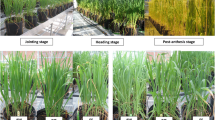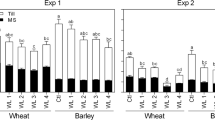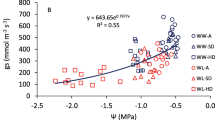Abstract
Awns illustrate an important photosynthetic organ of the cereal spike, especially under water stress. Barley (Hordeum vulgare L.) spikes are distinguished by long awns; nevertheless, the actual changes in barley awn dimensions under drought stress have not been adequately studied. In the present work, six barley genotypes with varying degrees of drought tolerance were investigated in a 2-year field experiment under well-watered (WW) and terminal drought stress (TDS) conditions based on randomized complete block design with three replications. The results showed that although TDS caused a notable reduction in awn dimensions compared to WW, the density of barbs on the awn surface significantly increased in all barley genotypes. In addition, the barb contact angle decreased significantly under TDS conditions compared to WW. Awn area had a significantly positive correlation with thousand grain weight and grain yield in both treatments and growing seasons. Also, highly significant correlations were observed between leaf stomatal conductance, awn area, and barb density under both conditions. In TDS, two genotypes demonstrated lower carbon isotope discrimination: Morocco, with higher awn dimensions, and PBYT 46, with a higher increase in barbs density on the awn surface and a lower canopy temperature. This research underlines barbs density on the awn surface by reflecting the light and a lower increase in the canopy temperature plays a more pivotal role than awn dimensions on water use efficiency in barley under terminal drought.










Similar content being viewed by others
References
Abebe T, Wise RP, Skadsen RW (2009) Comparative transcriptional profiling established the awn as the major photosynthetic organ of the barley spike while the lemma and the palea primarily protect the seed. Plant Genome 2:247–259
Abebe T, Melmaiee K, Berg V, Wise RP (2010) Drought response in the spikes of barley: gene expression in the lemma, palea, awn, and seed. Funct Integr Genomics 10:191–205
Adel S, Carels N (2023) Plant tolerance to drought stress with emphasis on wheat. Plants 12(11):2170
Alqaisi MR, Mohsin RM, Ahmed TS (2020) Efficiency of image analysis as a direct method in spore dimensions measurement. Plant Cell Biotechnol Mol Biol 21:57–64
Alqudah AM, Schnurbusch T (2017) Heading date is not flowering time in spring barley. Front Plant Sci 8:896
Aranjuelo I, Cabrera-Bosquet L, Morcuende R, Avice JC, Nogués S, Araus JL, Martínez-Carrasco R, Pérez P (2011) Does ear C sink strength contribute to overcoming photosynthetic acclimation of wheat plants exposed to elevated CO2? J Exp Bot 62:3957–3969
Araus JL, Brown HR, Febrero A, Bort J, Serret MD (1993) Ear photosynthesis, carbon isotope discrimination and the contribution of respiratory CO2 to differences in grain mass in durum wheat. Plant Cell Environ 16:383–392
Asseng S, Van Herwaarden AF (2003) Analysis of the benefits to wheat yield from assimilates stored prior to grain filling in a range of environments. Plant Soil 256:217–229
Avila CF, Moreira GM, Nicolli CP, Gomes LB, Abreu LM, Pfenning LH, Haidukowski M, Moretti A, Logrieco A, Del Ponte EM (2019) Fusarium incarnatum-equiseti species complex associated with Brazilian rice: phylogeny, morphology and toxigenic potential. Int J Food Microbiol 306:108267
Ayeneh A, Van Ginkel M, Reynolds MP, Ammar K (2002) Comparison of leaf, spike, peduncle and canopy temperature depression in wheat under heat stress. F Crop Res 79:173–184
Blum A (1985) Photosynthesis and transpiration in leaves and ears of wheat and barley varieties. J Exp Bot 36:432–440
Blum A (1986) The effect of heat stress on wheat leaf and ear photosynthesis. J Exp Bot 37:111–118
Blum A (2018) Plant breeding for stress environments. CRC Press
Bort J, Febrero A, Amaro T, Araus JL (1994) Role of awns in ear water-use efficiency and grain weight in barley. Agronomie 14(2):133–139
Carvalho JO, Toebe M, Tartaglia FL, Bandeira CT, Tambara AL (2017) Leaf area estimation from linear measurements in different ages of crotalaria juncea plants. An Acad Bras Ciênc 89:1851–1868
Chen GD, Li HB, Zheng Z, Wei YM, Zheng YL, McIntyre CL, Zhou MX, Liu CJ (2012) Characterization of a QTL affecting spike morphology on the long arm of chromosome 3H in barley (Hordeum vulgare L.) based on near isogenic lines and a NIL-derived population. Theor Appl Genet 125:1385–1392
Datcu AD, Sala F, Ianovici N (2017) Studies regarding some morphometric and biomass allocation parameters in the urban habitat on Plantago major. Res J Agric Sci 49(4):96–102
del Moral LFG, del Moral MBG, Molina-Cano JL, Slafer GA (2003) Yield stability and development in two-and six-rowed winter barleys under Mediterranean conditions. F Crop Res 81:109–119
Ehdaie B, Alloush GA, Waines JG (2008) Genotypic variation in linear rate of grain growth and contribution of stem reserves to grain yield in wheat. Field Crop Res 106(1):34–43
El Said SH, Hegazi AA, Allatif AMA (2013) Histological indicators of dwarfism of some olive cultivars. World Appl Sci J 28(6):835–841
Elbaum R, Zaltzman L, Burgert I, Fratzl P (2007) The role of wheat awns in the seed dispersal unit. Science 316(5826):884–886
Fan L, Linker R, Gepstein S, Tanimoto E, Yamamoto R, Neumann PM (2006) Progressive inhibition by water deficit of cell wall extensibility and growth along the elongation zone of maize roots is related to increased lignin metabolism and progressive stelar accumulation of wall phenolics. Plant Physiol 140:603–612
Farquhar GD, Richards RA (1984) Isotopic composition of plant carbon correlates with water-use efficiency of wheat genotypes. Funct Plant Biol 11:539–552
Gebbing T, Schnyder H (2001) 13C labeling kinetics of sucrose in glumes indicates significant refixation of respiratory CO2 in the wheat ear. Funct Plant Biol 28:1047–1053
Guo Z, Schnurbusch T (2016) Costs and benefits of awns. J Exp Bot 67(9):2533–2535
Hein JA, Sherrard ME, Manfredi KP, Abebe T (2016) The fifth leaf and spike organs of barley (Hordeum vulgare L.) display different physiological and metabolic responses to drought stress. BMC Plant Biol 16:1–12
Hosseini SM, Poustini K, Siddique KHM, Palta JA (2012) Photosynthesis of barley awns does not play a significant role in grain yield under terminal drought. Crop Pasture Sci 63:489–499
Hua L, Wang DR, Tan L, Fu Y, Liu F, Xiao L, Zhu Z, Fu Q, Sun X, Gu P (2015) LABA1, a domestication gene associated with long, barbed awns in wild rice. Plant Cell 27:1875–1888
Huang D, Zheng Q, Melchkart T, Bekkaoui Y, Konkin DJ, Kagale S, Martucci M, You FM, Clarke M, Adamski NM, Chinoy C (2020) Dominant inhibition of awn development by a putative zinc-finger transcriptional repressor expressed at the B1 locus in wheat. New Phytol 225(1):340–355
Huang B, Wu W, Hong Z (2021) Genetic loci underlying awn morphology in Barley. Genes 12:1613
Hubick K, Farquhar G (1989) Carbon isotope discrimination and the ratio of carbon gained to water lost in barley cultivars. Plant Cell Environ 12:795–804
Jia S, Lv J, Jiang S, Liang T, Liu C, Jing Z (2015) Response of wheat ear photosynthesis and photosynthate carbon distribution to water deficit. Photosynthetica 53:95–109
Jiang Q, Roche D, Hole DJ (2006) Carbon isotope discrimination of two-rowed and six-rowed barley genotypes under irrigated and non-irrigated field conditions. Can J Plant Sci 86:433–441
Kong L, Wang F, Feng B, Li S, Si J, Zhang B (2010) The structural and photosynthetic characteristics of the exposed peduncle of wheat (Triticum aestivum L.): an important photosynthate source for grain-filling. BMC Plant Biol 10(1):1–10
Kulić IM, Mani M, Mohrbach H, Thaokar R, Mahadevan L (2009) Botanical ratchets. Proc R Soc B Biol Sci 276:2243–2247
Kuusk S, Sohlberg JJ, Eklund DM, Sundberg E (2006) Functionally redundant SHI family genes regulate Arabidopsis gynoecium development in a dose-dependent manner. Plant J 47(1):99–111
Lawlor DW (2002) Limitation to photosynthesis in water-stressed leaves: stomata vs. metabolism and the role of ATP. Ann Bot 89:871–885
Li X, Bin D, Hong-Gang W (2010) Awn anatomy of common wheat (Triticum aestivum L.) and its relatives. Caryologia 63:391–397
Li P, Chen J, Wu P (2011) Agronomic characteristics and grain yield of 30 spring wheat genotypes under drought stress and nonstress conditions. Agron J 103(6):1619–1628
Li B, Förster C, Robert CA, Züst T, Hu L, Machado RA, Berset JD, Handrick V, Knauer T, Hensel G, Chen W (2018) Convergent evolution of a metabolic switch between aphid and caterpillar resistance in cereals. Sci Adv 4(12):6797
Martinez DE, Luquez VM, Bartoli CG, Guiamet JJ (2003) Persistence of photosynthetic components and photochemical efficiency in ears of water-stressed wheat (Triticum aestivum). Physiol Plant 119:519–525
Maydup ML, Antonietta M, Graciano C, Guiamet JJ, Tambussi EA (2014) The contribution of the awns of bread wheat (Triticum aestivum L.) to grain filling: responses to water deficit and the effects of awns on ear temperature and hydraulic conductance. F Crop Res 167:102–111
Mogensen VO (1992) Effect of drought on growth rate of grains of barley. Cereal Res Communi 20(3/4): 225–231
Moghaddam A, Raza A, Vollmann J, Ardakani MR, Wanek W, Gollner G, Friedel JK (2013) Carbon isotope discrimination and water use efficiency relationships of alfalfa genotypes under irrigated and rain-fed organic farming. Eur J Agron 50:82–89
Motzo R, Giunta F (2002) Awnedness affects grain yield and kernel weight in near-isogenic lines of durum wheat. Aust J Agric Res 53:1285–1293
Narisetti N, Awais M, Khan M, Stolzenburg F, Stein N, Gladilin E (2023) Awn image analysis and phenotyping using BarbNet. Plant Phenomics 5:0081
Ntakirutimana F, Xie W (2019) Morphological and genetic mechanisms underlying awn development in monocotyledonous grasses. Genes 10(8):573
Ntakirutimana F, Xie W (2020) Unveiling the actual functions of awns in grasses: from yield potential to quality traits. Int J Mol Sci 21(20):7593
Panozzo JF, Eagles HA, Cawood RJ, Wootton M (1999) Wheat spike temperatures in relation to varying environmental conditions. Aust J Agric Res 50:997–1006
Pask A, Pietragalla J, Mullan D, Reynolds M (2012) Physiological Breeding: A field guide to wheat phenotyping. II. CIMMYT, Mexico
Passioura JB, Condon AG, Richards RA (1993) Water deficits, the development of leaf area and crop productivity. In: Smith, JAC, Griffiths H (ed) Water deficits plant responses from cell to community. pp. 253–264. BIOS Scientific Publ., Oxford
Rachmilevitch S (2006) Physiological and biochemical indicators for stress tolerance. In: Huang B (ed) Plant-environment interactions, 3rd edn. Boca Raton, CRC Press, pp 321–356
Rangani J, Panda A, Patel M, Parida AK (2018) Regulation of ROS through proficient modulations of antioxidative defense system maintains the structural and functional integrity of photosynthetic apparatus and confers drought tolerance in the facultative halophyte salvadora persica L. J Photochem Photobiol B 189:214–233
Rebetzke GJ, Condon AG, Richards RA, Farquhar GD (2002) Selection for reduced carbon isotope discrimination increases aerial biomass and grain yield of rainfed bread wheat. Crop Sci 42:739–745
Rebetzke GJ, Bonnett DG, Reynolds MP (2016) Awns reduce grain number to increase grain size and harvestable yield in irrigated and rainfed spring wheat. J Exp Bot 67(9):2573–2586
Rizza F, Ghashghaie J, Meyer S, Matteu L, Mastrangelo AM, Badeck FW (2012) Constitutive differences in water use efficiency between two durum wheat cultivars. F Crop Res 125:49–60
Samarah NH (2005) Effects of drought stress on growth and yield of barley. Agron Sustain Dev 25(1):145–149
Samarah NH, Alqudah AM, Amayreh JA, McAndrews GM (2009) The effect of late-terminal drought stress on yield components of four barley cultivars. J Agron Crop Sci 195:427–441
Sanchez-Bragado R, Molero G, Reynolds MP, Araus JL (2014) Relative contribution of shoot and ear photosynthesis to grain filling in wheat under good agronomical conditions assessed by differential organ δ13C. J Exp Bot 65:5401–5413
Sánchez-Díaz M, García JL, Antolín MC, Araus JL (2002) Effects of soil drought and atmospheric humidity on yield, gas exchange, and stable carbon isotope composition of barley. Photosynthetica 40:415–421
Schaller CW, Qualset CO (1975) Isogenic analysis of productivity in barley: interaction of genes affecting awn length and leaf-spotting 1. Crop Sci 15:378–382
Siddique KHM, Tennant D, Perry MW, Belford RK (1990) Water use and water use efficiency of old and modern wheat cultivars in a Mediterranean-type environment. Aust J Agric Res 41:431–447
Tambussi EA, Nogués S, Araus JL (2005) Ear of durum wheat under water stress: water relations and photosynthetic metabolism. Planta 221:446–458
Tambussi EA, Bort J, Guiamet JJ, Nogués S, Araus JL (2007) The photosynthetic role of ears in C3 cereals: metabolism, water use efficiency and contribution to grain yield. CRC Crit Rev Plant Sci 26:1–16
Tavakol E, Jákli B, Cakmak I, Dittert K, Karlovsky P, Pfohl K, Senbayram M (2018) Optimized potassium nutrition improves plant-water-relations of barley under PEG-induced osmotic stress. Plant Soil 430:23–35
Teich, AH (1982) Interaction of awns and environment on grain yield in winter wheat (Triticum aestivum L.). Cereal Res Commun 10(1/2):11–15
Thabet SG, Moursi YS, Karam MA, Börner A, Alqudah AM (2020) Natural variation uncovers candidate genes for barley spikelet number and grain yield under drought stress. Genes 11(5):533
Thameur A, Lachiheb B, Ferchichi A (2012) Drought effect on growth, gas exchange and yield, in two strains of local barley ardhaoui, under water deficit conditions in southern Tunisia. J Environ Manag 113:495–500
Weyhrich RA, Carver BF, Smith EL (1994) Effect of awn suppression on grain yield and agronomic traits in hard red winter wheat. Crop Sci 34:965–969
Würschum T, Jähne F, Phillips AL, Langer SM, Longin CF, Tucker MR, Leiser WL (2020) Misexpression of a transcriptional repressor candidate provides a molecular mechanism for the suppression of awns by tipped 1 in wheat. J Exp Bot 71(12):3428–3436
Yang Y, Li N, Wu Y, Liu B, Li S, Tao L, Zhan Y, Yang Y, Ni X (2022) Key phenotypes related to wheat grain yield in a two-site multicultivar test. Agron J 114(5):2874–2885
Yazdani B, Sanjari S, Asghari-Zakaria R, Ghanegolmohammadi F, Pourabed E, Shahbazi M (2020) Revision of the barley WRKY gene family phylogeny and expression analysis of the candidate genes in response to drought. Biol Plant 64(1):9–19
Yuo T, Yamashita Y, Kanamori H, Matsumoto T, Lundqvist U, Sato K, Ichii M, Jobling SA, Taketa S (2012) A SHORT INTERNODES (SHI) family transcription factor gene regulates awn elongation and pistil morphology in barley. J Exp Bot 63(14):5223–5232
Zadoks JC, Chang TT, Konzak CF (1974) A decimal code for the growth stages of cereals. Weed Res 14:415–421
Zhao J, Liu Y, Cheng X, Pang Y, Li J, Su Z, Wu J, Yang Q, Bai G, Chen X (2019) Development and identification of a dwarf wheat-Leymus mollis double substitution line with resistance to yellow rust and fusarium head blight. Crop J 7(4):516–526
Zhou Y, Lam HM, Zhang J (2007) Inhibition of photosynthesis and energy dissipation induced by water and high light stresses in rice. J Exp Bot 58:1207–1217
Zhou B, Sanz-Sáez Á, Elazab A, Shen T, Sánchez-Bragado R, Bort J, Serret MD, Araus JL (2014) Physiological traits contributed to the recent increase in yield potential of winter wheat from Henan Province. China J Integrc Plant Biol 56(5):492–504
Funding
This research did not receive any specific grant from funding agencies in the public, commercial, or not-for-profit sectors.
Author information
Authors and Affiliations
Corresponding author
Ethics declarations
Competing interest
The authors declare that they have no known competing financial interests or personal relationships that could have appeared to influence the work reported in this paper.
Additional information
Communicated by Hakan Özkan.
Supplementary Information
Below is the link to the electronic supplementary material.
Rights and permissions
Springer Nature or its licensor (e.g. a society or other partner) holds exclusive rights to this article under a publishing agreement with the author(s) or other rightsholder(s); author self-archiving of the accepted manuscript version of this article is solely governed by the terms of such publishing agreement and applicable law.
About this article
Cite this article
Afshari-Behbahanizadeh, S., Akbari, GA., Shahbazi, M. et al. Barley awn dimensions and barbs changes under terminal drought stress and its relation to grain yield and carbon isotope discrimination. CEREAL RESEARCH COMMUNICATIONS (2024). https://doi.org/10.1007/s42976-024-00511-9
Received:
Accepted:
Published:
DOI: https://doi.org/10.1007/s42976-024-00511-9




